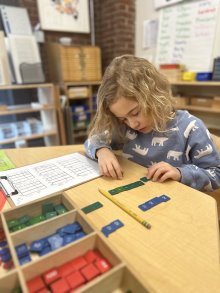
Kingsley's Math Specialist, Bethany Hoekzema, explains number sense and how it helps tackle complex math concepts
One of the most important foundations in early math development is number sense—the ability to understand and work with numbers in a flexible, confident way. Number sense is more than just recognizing numbers; it’s about deeply understanding what numbers represent and how to relate, compare, and manipulate them. These skills don’t come from memorization alone—they develop through hands-on experiences, games, conversations, and guided activities that invite children to explore numbers.
Number sense is just as visible in Kindergarten as in Sixth Grade, and children can think deeply about numbers at any level. For preschool children, number sense begins with simple activities like counting objects, recognizing patterns, and comparing or sharing in everyday activities. As children progress through elementary school, they begin to see numbers as part of a larger system, and they master more types of numbers, as well as the relationships between those types. Whether they are Kindergarteners exploring numbers up to 10, Second Graders digging into three-digit numbers, or Fourth Graders learning about decimals, children of every age first build a solid understanding of new numbers through hands-on learning with concrete tools, then move on to abstract thinking with drawings, diagrams, and written numerals.
When teachers talk about number sense, they also mean how students can strategically apply their understanding of numbers. A key development for early elementary students is learning to break numbers apart and reassemble them flexibly to solve problems. Students with strong number sense are more prepared to solve problems mentally, and they can choose from multiple strategies to find the most efficient one for a given problem. They are able to use estimation to determine if their answer is reasonable, and they can come up with creative ways to apply what they know about numbers to an unfamiliar problem.
What does it look like for a student to build number sense? A student in Kindergarten may use her fingers or the dot pattern on a domino to see that 8 is made up of 5 and 3. Later, with opportunities to explore hands-on materials, she will build on that relationship to also see 80 as made up of 50 and 30, or one whole as made up of ⅝ and ⅜ . The student may eventually use this relationship to solve an abstract problem like 13 - 8 or 56 + 80 or 2 - ⅜ without using memorized steps. Written problem sets don’t often give us insight into how students are reasoning, so teachers facilitate Number Talks and one-on-one conversations with students to get a peek inside their developing math brains. Take the opportunity to ask your child, “How do you know that’s true?” the next time they solve a math problem. You may be surprised by how sophisticated their reasoning is!
The stronger your child’s number sense, the easier it will be for them to tackle more complex math concepts later on. Engaging with math in a fun, stress-free way helps your child build a positive relationship with math that will keep them learning and exploring. Below are some simple ways to incorporate math into everyday activities and help your child build number sense and confidence!
Math at Home: PreK to 1st Grade
Math at Home: 1st to 3rd Grade







.jpg&command_2=resize&height_2=85)







.jpg&command_2=resize&height_2=85)
.jpg&command_2=resize&height_2=85)





